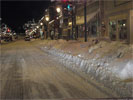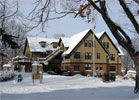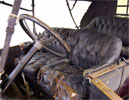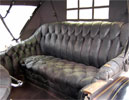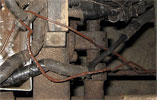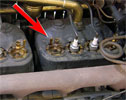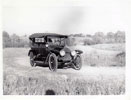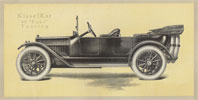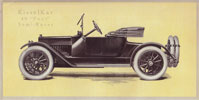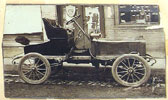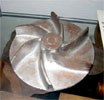
A Rendezvous with Annie
Hartford, Wisconsin—Dec. 10-12, 2008
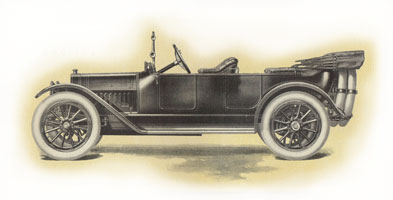 |
| This beautiful graphic of a 1914 KisselKar 4-40 Touring is adopted from a Kissel Motor Car Company advertizing pamphlet. |
Last update: Jan. 9, 2009
With Help From His Friends
In October, 2009, Lynn and Jeanne purchase Annie (their name for the 1914 KisselKar Touring formerly owned by Ann Klein), sight unseen, from Hyman Ltd Classic Cars, St. Louis, MO. They make arrangements for her to be delivered directly to the Wisconsin Automotive Museum in Hartford, WI. Annie was delivered to the museum on November 14, so it's high time for Lynn to go and take a good look at her.
Lynn has been mentally preparing himself for this visit. Annie is a well-known car and has been pictured in histories of the Kissel Motor Car Company dating back over 50 years (see, for example, Husting's 1955 article). Although he has high hopes and wild fantasies about the car based on the sellers description and other information, he fully expects that the car will have a hard time living up to all the hype. He's already learned through communications with Klein Kars in Lancaster, PA (place where Ann Klein kept the car) that the car is not as pristine and original as has been implied by the sales descriptions prepared for auctions over the last year.
He's been through this before. The initial condition of both Bugsby and Penny at first depressed him, but eventually he recovered and was glad that he had acquired them. With Bugsby it took a couple of months; with Penny it takes many weeks. Hopefully the decreasing length of Lynn's bout with buyer's remorse is a positive trend. Let's see how long it takes with Annie.
Without a doubt, Lynn has been getting help from his friends. Some of it is solicited, some is not. Dale Anderson has agreed to receive and display the car in the Hartford museum. This is a huge help as Lynn doesn't have the space, time or energy to deal with her in California at this moment.
At Lynn's request, Dale has provided names and contact information of an antique upholsterer and mechanic in the Hartford area. Lynn intends to meet with both these men during his visit to Hartford and initiate some work on the car.
Lynn has been communicating extensively with Andrew Wilson (owner of Herman, a 1914 KisselKar 4-40 Touring) and John Quam (owner of a 1914 KisselKar 4-40 Semi-Racer). Both of these individuals enthusiastically support Lynn by sharing information and wisdom that they've acquired about their cars. With their cooperation, Lynn creates webpages on their cars. While he hopes that Andrew and John feel the pages are a positive contribution to their own efforts, Lynn is particularly grateful to them as this is an exercise for him to gain deeper insight into Annie.
Of course, Lynn immediately turns to his Kissel pal, Joe Leaf, for advice and comfort. Lynn and Joe have multiple long phone conversations and email exchanges. On more than one point, Joe steers Lynn's thinking in a positive direction. Lynn also reaches out and touches other Kissel owners, all of whom positively support his efforts and provide helpful details.
So Lynn has done his homework. Let's see how the trip to Hartford unfolds.
It Will Be a Cold Day in Hartford
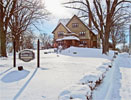 |
||
Downtown Hartford upon Lynn's late arrival Tuesday night (left). Views of the Westphal Mansion Wednesday morning (center, right).
|
||
As luck would have it, Lynn arrives by airplane in Chicago in the middle of the worst storm of the early winter season. As he leaves Chicago by car to drive the 130 miles to Hartford, the heavy snowfall begins to accumulate on the roads. Soon he's crawling along in heavy traffic at 10 mph on I-94 near the shore of Lake Michigan. Eventually the Chicago traffic thins out and Lynn makes better speed on snow-packed roads. Having spent his early driving years in Western New York, in the snow belt outside of Buffalo, Lynn is familiar with these driving conditions. In spite of the poor conditions, Lynn enjoys the experience of winter driving. He arrives in Hartford to a fresh, heavy snowfall. It's really quite beautiful.
At the recommendation of Dale Anderson, Lynn has booked lodging at the Westphal Mansion Inn Bed and Breakfast, one block off downtown Hartford and three blocks from the museum. While more expensive than your standard motel, the Westphal is a beautiful 1913 mansion, carefully furnished by Pamela and Garret with antique furniture and artifacts. As a special treat, the Westphal is decked out in antique holiday decorations. On Saturday, the day Lynn is scheduled to leave town, an area historic home tour is planning to stop for a visit at the mansion. Naturally, the owners are excited and proud to show off their restoration of the mansion to others.
Lynn stays in Suite 1, and is so impressed with his stay (including his four-course gourmet breakfasts) that he books a room for June, 2009. This is in anticipation of Jeanne and Lynn's next visit to Hartford for a KisselKar Klub meeting and car show.
Just Like a Fine Pie Crust
Sales photos show that the seats are an obvious issue, but can they be repaired?
|
|||
Lynn is predisposed toward the preservation branch of antique car ownership which is much in vogue these days. As a result, Lynn's immediate plans for Annie revolve around repairing only what is unserviceable. He tries to ignore multiple unsolicited suggestions from people he barely knows telling him not to touch anything on the car. As those who know him better understand, Lynn is an independent cuss and telling him what he should do is more likely to precipitate the opposite result.
Before he heads to Hartford, Lynn contacts Jerry, an antique upholsterer highly recommended by Dale, and makes an appointment to meet him at the museum. Lynn's idea as he expresses it to Jerry is to attempt repairs to the upholstery rather that wholesale replacement. From the sales photos it appears likely that this strategy might work.
As it turns out, the leather upholstery is way beyond repair. It is so dry, thin and brittle that it has the consistency of a fine pie crust. Lynn can easily poke his index finger through portions of the seat that visually appear salvageable.
Although the estimate is not cheap, Lynn commissions replacement of the leather seats and rear carpeting. He will retain the existing tooled-leather door panels. All the wood and springs of the seats are in excellent condition and will be reused.
Two Times Six Is Not Twelve
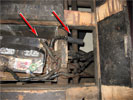 |
|||
The battery box (left, note sections of heater hose that have been used to insulate two of the four battery cables). Many wires show evidence of overheating (center, right).
|
|||
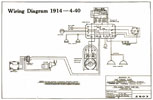 |
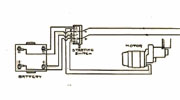 |
| The wiring diagram (left) and battery, starter switch, starter motor detail (right) are extracted from the 1914 Instruction Manual. (1914 KisselKar Instructions courtesy of Andrew Wilson) | |
The 1914 KisselKar 4-40 has a dual-voltage electrical system. The generator, lights and ignition coil operate on 6V while the starter motor requires 12V. Most of the time the system is configured for 6V. When the starter switch is pushed, mechanical linkage to a transfer switch under the right-front seat reconfigures the system to apply 12V to the starter motor. The original battery had four terminals and was essentially two 6V batteries in a single case.
(Annie has a duel ignition system using a battery and coil for easy starting and a magneto once the car is running. The high-tension Bosch DU-4 magneto is a completely self contained ignition system, requiring no external electrical supply. This magneto effectively combines a generator, coil, points/interrupter and distributor in a single unit.)
Apparently these facts were unknown to the individuals who were most recently in possession of the vehicle. Lynn finds a single 12V Kirtland (Costco brand) battery installed in the car. One can see in the photo that two of the four battery leads have been insulated with 3" sections of heater hose.
Lynn wonders what damage has been done to the electrical system on the car. There is ample evidence of overheating wires as witnessed by the bubbled and melted plastic insulation. Lynn is less concerned about the wires as these plastic covered wires will need to be replaced anyway with period appropriate cloth covered wires. Rather he is concerned about other components such as the lights, horn and the generator.
As Lynn has learned from John Quam, the Esterline E-6 generator used on the 1914 KisselKar is a rare item. It was only used for one or two years by Kissel, and used briefly by only a few low-volume manufacturers. The generator was missing when John acquired his 1914 Semi-Racer and he had a hard time locating one. Lynn will be really unhappy if Annie's generator has been damaged through what appears to be the recent installation of the 12V battery.
Lynn has arranged with Tom, a mechanic in Hartford recommended by Dale Anderson, to have two 6V batteries installed. Lynn prints out his webpage on Herman and suggests Tom follow Andrew Wilson's electrical configuration.
Sales photo of left-hand side of engine shows undamaged primer cups on all cylinders.
|
||||
Lynn spots what appears to be another example of recent abuse. While inspecting the engine, he notes that the arm on the primer cup on cylinder three is broken and missing. So it comes as something of an unpleasant surprise for Lynn when he re-examines the sales photos and sees that the arm was intact within the last year.
Searching For Nuggets in a Gold Mine
Based on his previous exposure to the Kissel files at the museum during the 100-year anniversary celebration in 2006, Lynn hopes that he will again find many pieces of information. In fact, he thinks long and hard about how he will capture this information. He will not be satisfied with low-quality black-and-white photocopies.
Lynn comes to Hartford with a new Sony VAIO laptop computer and new Canon CanoScan LiDE 200 flatbed scanner. This scanner is relatively small and light, and it runs off a single USB cable to the computer that supplies both data communications and power. The scanner captures great images directly to PDF (Adobe's Portable Document Format), or can be used to scan images into Photoshop for additional manipulation. The only real drawback with this digital-imaging arrangement is the 8.5"x11" (A4) size limit and speed of the scanner.
As a second imaging option, he cobbles together a suction-cup camera tripod using parts from his racecar track video days. Lynn's trying to create a poorman's document camera. Attaching the suction-cup tripod to a table top, and connecting his Canon SD700is digital camera to the tripod, Lynn can quickly photograph documents that he places on a chair or on the floor under the camera. The camera is much faster than the scanner, capturing images of varying size. The major drawback is that items such as pamphlets don't want to lie perfectly flat. If he had more time, he could have gotten a sheet of glass and arranged desk lamps as indirect illumination instead of using the camera's built-in flash. Maybe he'll try this modification next time he's capturing items from the Kissel files.
Using either the computer and scanner, or camera and tripod, Lynn captures many great items from the archives. Lynn is so pleased with the results, he begins to think that he should arrange at some indefinite time in the future (maybe once he's retired) to come back to Hartford and digitize all the information in the Kissel files.
Kissel Items On Display
While in Hartford, Lynn makes a photo survey of the Kissel cars in the museum. By his count there are twenty-two Kissel vehicles which includes three trucks. In order of age, he finds:
- 1912 4-40 Touring — unrestored
- 1914 4-40 Touring — this is Annie
- 1918 1.5-ton truck chassis
- 1921 6-45 Speedster
- 1923 4-32 1.5-ton truck
- 1923 6-55 4-door Brougham
- 1923 6-55 5-passenger Phaeton — restored
- 1923 6-55 5-passenger Phaeton — an "in process" restoration
- 1923 "pre-restoration" 6-55 5-passenger Phaeton
- 1925 6-55 Enclosed Speedster
- 1925 8-75 4-door Brougham
- 1925 8-75 Enclosed Speedster
- 1926 6-55 Coupe Roadster
- 1926 8-75 Deluxe Brougham
- 1926 fire truck
- 1927 6-55 Speedster
- 1927 8-65 4-door Brougham
- 1928 8-80 Brougham Deluxe
- 1928 8-90 White Eagle Brougham
- 1929 8-95 White Eagle Coupe Roadster
- 1930 8-95 White Eagle Brougham
- 1930 8-95 White Eagle Touring
The museum has the personal scrap book of William Kissel (one of the company founders) on display. The pages are individually mounted within oak-framed glass panels that can be turned to examine both sides of the sheet. Lynn photographs each of the 50 odd pages of the scrap book and is pleased to find later that he can easily read the contents of each page when he magnifies the images on his computer. The only problem with this technique is that he uses the camera's built-in flash for illumination so he needs to photograph the pages from an angle to avoid glare off the glass. He will need to do some fancy image manipulation with Photoshop to remove the resulting keystone distortion.
Other interesting Kissel displays in the museum capture Lynn's attention. There is a wonderful three-panel exhibit showing one sample Kissel vehicle for each model year from the first experimental Kissel car in 1905 through to a 1931 Ruxton. Another display shows about 50 individual photos of work sites within various departments in the Kissel plant in the 1920s. Still another case displays wood patterns that were used as molds for sand casting many Kissel parts. Lynn immediately recognizes the pattern used to create the impeller blade in the water pump of his 1924 Speedster.
Lynn Gets Over It
As he expects, Lynn initially feels mildly depressed and is frustrated as the full impact of the Annie's current condition sinks in. His new baby needs more attention than he had hoped she would; he's facing a huge bill for the upholstery work; the full extent of the damage to the electrical system has yet to be determined.
Then there is that recent tear in the top. He does not plan to fix it and it will unfortunately add to the car's patina. It is also irritating to have one of the primer cup handles broken off. He wishes he could pinch the ear of whoever did that to Annie. Maybe he can fix it once he gets her in his own garage.
Still he has set in motion what he expects to be an excellent upholstery restoration. His contract specifically states that the work must be completed well in advance of the June 2009 KisselKar Klub meeting in Hartford. (Lynn makes a mental note to himself; he'll have to monitor progress to make sure that the work is completed on schedule.) It will be really sweet to pull Annie out of the museum for the show with her new interior.
While the extent of the electrical issue is unknown, Lynn's arrangement with Tom will likely result in some more detailed information. If Lynn's lucky (and he often is), two new 6V batteries may completely solve the immediate problem. Over time, once the car is in his own garage, Annie will get those plastic wires replaced with cloth-covered wires.
On the airplane ride home to California, as Lynn is staring out of the window and thinking of everything that happened over the last five days, he unexpectedly feels a little bit of that "spring is finally here" or "it's Christmas time" kind of joy in his chest. Yes, he thinks, Annie is going to turn out alright after all.
In time the memory of these short-term problems will fade and Lynn be the proud owner of a rare and beautiful, correctly configured and operating vehicle. He can't wait until the car is stable enough to drive around town and take on tours.
Heck, before you know it, Annie will be 100 years old! Now won't that be a kick. Yahoo!
Contact
 with your comments or questions
with your comments or questionsCopyright © 2018 Lynn Kissel
Last updated: May 24, 2009
